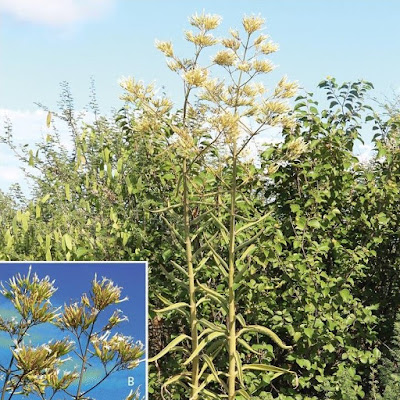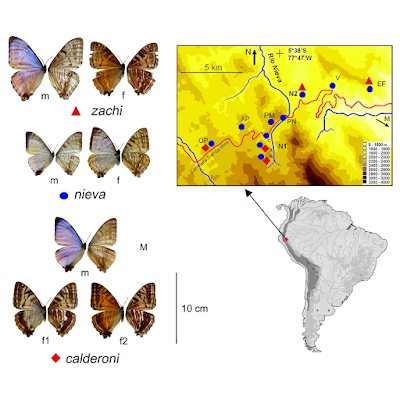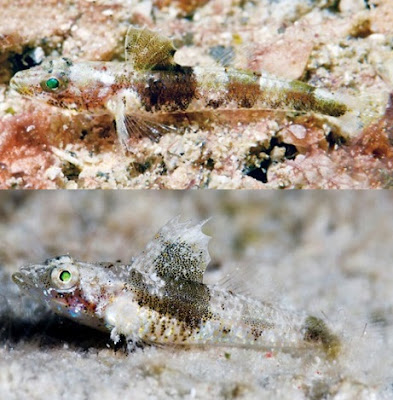![]() |
Amblyrhynchus cristatus godzilla
|
Abstract
Marine iguanas are among the most highly emblematic taxa of the Galápagos archipelago but have paradoxically received little attention from taxonomists. Amblyrhynchus is currently considered as a monotypic genus with a total of seven subspecies, A. cristatus cristatus, A. c. nanus, A. c. venustissimus, A. c. albemarlensis, A. c. hassi, A. c. mertensi and A. c. sielmanni. Although consensually followed for more than half a century, this classification does not properly reflect the main natural subdivisions inferred by more recent molecular evolutionary studies. We integrate population genetics, phylogenomics and comparative morphology to propose an updated taxonomy reflecting the evolutionary history of this group. We recognize a single species with 11 divergent population clusters at the level of subspecies: A. c. albermarlensis is recognized as a junior synonym of A. c. cristatus, and five new subspecies are described: Amblyrhynchus cristatus godzilla subsp. nov. (San Cristóbal-Punta Pitt),A. c. jeffreysi subsp. nov. (Wolf and Darwin), A. c. hayampi subsp. nov. (Marchena), A.c. trillmichi subsp. nov. (Santa Fé) and A. c. wikelskii subsp. nov. (Santiago). Recognizing the genetically divergent population clusters as subspecies also highlights several of them as management units in need of conservation efforts, such as the two subspecies endemic to San Cristóbal.
Keywords: Amblyrhynchus, Galápagos, integrative taxonomy, management units (MUs), Marine Iguana, new subspecies.
![]() |
| Fig 5: Overview of the phenotypic diversity among Amblyrhynchus cristatus subspecies: (A–C) Amblyrhynchus cristatus hassi from Santa Cruz (SFM 57412, 57407, 57408) (D–F) A. c. wikelskii subsp. nov. from Santiago (SFM 57447, 57448, 57446), (G–N) A. c. cristatus from Fernandina (OUMNH 6176, CAS 11512, 11511, 11510) and Isabela (SFM 64179, 11258, 65996, 65998), (O–Q) A. c. mertensi from San Cristóbal (SFM 57427, 57430, 57424), (R) A. c. trillmichi subsp. nov. (uncollected living specimen), (S) A. c. godzilla subsp. nov. (uncollected living specimen). HT: holotype, NT: neotype, PT: paratype. |
![]() |
| Fig 6: Overview of the phenotypic diversity among Amblyrhynchus cristatus subspecies.(A–D) Amblyrhynchus cristatus venustissimus from Champion (CAS 11062) and Española (SFM 57415, 49853, 57413), (E–G) A. c. sielmanni (CAS 12565, SFM 57417, CAS 12570), (H–J) A. c. nanus from Genovesa (NHM 1946.8.30.20, SFM 57432, SFM 57445), (K–N) A. c. hayampi subsp. nov. from Marchena (CAS 12467, 12458, 12449, 12471), (O–U) A. c. jeffreysi subsp. nov. from Wolf (CAS 12690, CAS-SUR 4777, CAS 12693, CAS 12961) and Darwin (CAS 12694, 12696, 12695). HT: holotype, PT: paratype. |
Amblyrhynchus cristatus Bell, 1825
Amblyrhynchus cristatus cristatus Bell, 1825 (Figs 5G–N, 7)
Amblyrhynchus cristatus nanus Garman, 1892 (Figs 6H–J, 7)
Amblyrhynchus cristatus venustissimus Eibl-Eibesfeldt, 1956 (Figs 6A–D, 7)
Amblyrhynchus cristatus hassi Eibl-Eibesfeldt, 1962 (Figs 5A–C, 7)
Amblyrhynchus cristatus mertensi Eibl-Eibesfeldt, 1962 (Figs 5O–Q, 7)
Amblyrhynchus cristatus sielmanni Eibl-Eibesfeldt, 1962 (Figs 6E–G, 7)
![]() |
Fig 7: Photographic plate showing the different subspecies of Marine Iguana (living mature males exclusively).
(A) Amblyrhynchus cristatus nanus, Genovesa, (B) A. c. hayampi subsp. nov., Marchena, (C) A. c. sielmanni, Pinta, (D, E) A. c. venustissimus, Española and Floreana, respectively, (F) A. c. trillmichi subsp. nov., Santa Fé, (G) A. c. hassi, Santa Cruz, (H) A. c. cristatus, Fernandina, (I) A. c. cristatus, Isabela, (J) A. c. mertensi, San Cristóbal, (K) A. c. godzilla subsp. nov., San Cristóbal, (L) A. c. wikelskii subsp. nov., Santiago.
Pictures from A. Ibañez (E, K), M. Krueger (A), H. Snell (B, D, H), S. Steinfartz (C, I, L), M. Vences (G, J), M. Vitousek (F). DOI: 10.1093/zoolinnean/zlx007 |
![]() |
Fig 8: Distribution of the different subspecies of Galápagos marine iguanas according to the classification of Eibl-Eibesfeldt (1962) and the new taxonomy proposed herein. The orange dot on the southern coast of San Cristóbal represents the population of putative migrant specimens of A. c. venustissimus.
|
Amblyrhynchus cristatus hayampi subsp. nov. (Figs 6K–N, 7, 9B)
Etymology: The subspecific epithet hayampi refers to the word used to designate the common iguana in Kichwa (a Quechuan language representing one of the three official languages of Ecuador and currently spoken by a million people in South America).
Geographic distribution: Marchena and very likely its satellite islets (Fig. 8).
Amblyrhynchus cristatus jeffreysi subsp. nov. (Figs 6O–U, 7, 9A)
Etymology: The subspecies name is a patronym for Jeffreys Málaga, a ranger of the Galápagos National Park with an outstanding interest and enthusiasm for the fauna and flora of the Galápagos, and especially for marine iguanas. Jeffreys Málaga has been awarded several times ‘Guardaparque del Año,’ or Park Warden of the Year and has been an essential part of our team during several excursions to the Galápagos.
Geographic distribution: Wolf, Darwin (tentative assignment), Roca Redonda and very likely their satellite islets (Fig. 8).
Amblyrhynchus cristatus godzilla subsp. nov. (Figs 5S, 7, 10)
Etymology: The subspecific epithet refers to the fictional saurian monster from the eponym movie franchise, Godzilla, created by Tomoyuki Tanaka (IMDb, 2016). Explicitly mentioned in the title sequence of the 1990s American remake (Emmerich, 1998), the physical appearance and swimming behaviour of marine iguanas were a significant source of inspiration to the creature′s designer (Patrick Tatopoulos, personal communication). The name is an invariable noun in apposition.
Geographic distribution: Northern (north-eastern) part of San Cristóbal and the satellite islets off the northern coast of San Cristóbal (Fig. 8).
Amblyrhynchus cristatus trillmichi subsp. nov. (Figs 5R, 7)
Etymology: The subspecific epithet refers to Prof. Dr. Fritz Trillmich, a foremost biological researcher in Germany who has spent a lifetime working on the biology of the Galápagos islands. For many years Fritz Trillmich worked together with Martin Wikelski on the island of Santa Fé, where their research on the local population produced important insights into the behaviour and ecology of marine iguanas. In addition to undertaking his own research, Fritz Trillmich is Professor Emeritus of Behavioural Ecology at the University of Bielefeld where he continues to inspire and mentor generations of young researchers who will continue his legacy for years to come.
Geographic distribution: Santa Fé and very likely its satellite islets (Fig. 8).
Amblyrhynchus cristatus wikelskii subsp. nov. (Figs 5D–F, 7, 9C)
Etymology: The subspecies name is a patronym for Prof. Dr. Martin Wikelski in recognition of his outstanding research on marine iguanas for several decades. Martin Wikelski has been fascinated by marine iguanas, which served as a study system for his behavioural and ecological research from his PhD onwards. He has published important papers on marine iguana ecology and conservation, for instance demonstrating the devastating effects of an oil spill on this species, and showing that marine iguanas can shrink in response to starvation induced by El Niño–based climate fluctuations.
Geographic distribution: Santiago, Rábida and very likely their satellite islets (Fig. 8).
Aurélien Miralles, Amy Macleod, Ariel Rodríguez, Alejandro Ibáñez, Gustavo Jiménez-Uzcategui, Galo Quezada, Miguel Vences and Sebastian Steinfartz. 2017. Shedding Light On the Imps of Darkness: An Integrative Taxonomic Revision of the Galápagos Marine Iguanas (Genus
Amblyrhynchus).
Zoological Journal of the Linnean Society. DOI:
10.1093/zoolinnean/zlx007
Godzilla of the Galápagos and other speciation stories
Godzilla marine iguana discovered on Galapagos
Conservation of threatened iconic marine iguanas improved by a new taxonomy




















































































